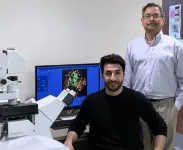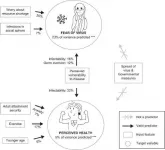(Press-News.org) Researchers at the University of Gothenburg, Sweden, have now presented results that may change our basic view of how type 2 diabetes occurs. Their study indicates that free fatty acids (FFAs) in the blood trigger insulin release even at a normal blood-sugar level, without an overt uncompensated insulin resistance in fat cells. What is more, the researchers demonstrate the connection with obesity: the amount of FFAs largely depends on how many extra kilos of adipose tissue a person carries, but also on how the body adapt to the increased adiposity.
Worldwide, extensive research is underway to clarify exactly what happens in the body as type 2 diabetes progresses, and why obesity is such a huge risk factor for the disease. For almost 50 years, diabetes researchers have been discussing their version of the chicken-or-egg question: Which comes first -- insulin resistance or elevated insulin levels? The dominant hypothesis has long been that the pancreas steps up its insulin production because the cells have already become insulin-resistant, and blood sugar then rises. However, the results now published in the journal EBioMedicine support the opposing idea: that it is the insulin that increases first.
Detailed investigations
The study indicates that high FFA levels in the blood after the overnight fast raise insulin production in the morning. FFAs have long been part of the main research equation for type 2 diabetes, but it is now proposed that they also have another role: in progression of the disease.
For the study, researchers compared metabolism in adipose (fat-storing) tissue among 27 carefully selected research subjects (nine of normal weight, nine with obesity and normal blood sugar, and nine with both obesity and progressed type 2 diabetes). For several days, they underwent extensive examinations in which they had samples taken under varying conditions. The researchers analyzed metabolism and gene expression in the participants' subcutaneous fat, and the levels of blood sugar, insulin, and FFAs in their blood.
FFAs seem to trigger insulin production
The people with obesity but not diabetes proved to have the same, normal blood-sugar levels as the healthy individuals of normal weight.
"Interestingly, the nondiabetics with obesity had elevated levels of both free fatty acids and insulin in their blood, and those levels were similar to or higher than the levels we were able to measure in blood from the participants with both obesity and type 2 diabetes," says Emanuel Fryk, resident doctor specializing in general medicine and doctoral student at Sahlgrenska Academy, University of Gothenburg, who is one of the study's first authors.
In collaboration with researchers at Uppsala University, he observed the same pattern in a population study based on blood samples taken from 500 people after an overnight fast.
"The fact that we saw a link between free fatty acids and insulin there too suggests that the fatty acids are connected with the insulin release, and contribute to increased insulin production on an empty stomach, when blood sugar hasn't risen," says Fryk, who nevertheless points out that the finding needs to be confirmed with more research.
Ongoing research
Free fatty acids are found naturally in the bloodstream and, like glycerol, are a product of the body's fat metabolism. In the subjects, the amount of glycerol released proved to be broadly the same per kilo of body fat, regardless of whether they were of normal weight, had obesity alone, or also had type 2 diabetes.
"Our hypothesis is that the free fatty acids increase in the blood because the adipose tissue can't store the excess energy anymore. We believe, in that case, it could be an early sign of incipient type 2 diabetes. If our findings are confirmed when other research methods are used, there may be a chance that some specific fatty acids could be developed into biomarkers. But that's a long way off," Fryk says.
Lifestyle crucial
Diabetes is one of the most common diseases, with an estimated 500,000 people affected in Sweden. There are also a large number of undetected cases, since many with type 2 diabetes are not yet aware they are ill. Diabetics are at an increased risk for a number of serious conditions, such as cardiovascular disease (which may result in heart attacks and strokes).
"There are many factors that contribute to the progression of type 2 diabetes, but it's our lifestyle that has, in absolute terms, the largest impact for most people. Our study provides another argument that the most important thing you can do to slow diabetes progression is to change your life style early in the progression of the disease, before blood glucose is elevated, Fryk says.
INFORMATION:
Title: Hyperinsulinemia and insulin resistance in the obese may develop as part of a homeostatic response to elevated free fatty acids: A mechanistic case-control and a population-based cohort study; EBioMedicine. Link to article: https://www.thelancet.com/action/showPdf?pii=S2352-3964%2821%2900057-8
Contact:
Emanuel Fryk, doctoral student at Sahlgrenska Academy, University of Gothenburg, phone: 46 736 977 622, email: emanuel.fryk@wlab.gu.se
Per-Anders Jansson, Professor of Translational Medical Research at Sahlgrenska Academy, University of Gothenburg, email: per-anders.jansson@wlab.gu.se
Researchers at the University of Illinois Chicago have discovered that heparanase, HPSE, a poorly understood protein, is a key regulator of cells' innate defense mechanisms.
Innate defense responses are programmed cellular mechanisms that are triggered by various danger signals, which have been conserved in many species throughout evolution. These systems can be set into action by pathogens, such as viruses, bacteria and parasites, as well as by environmental toxins and dysfunctional cells that can accumulate in the body over time. A more thorough understanding ...
The U.S. criminal legal system has expanded at a rapid pace, even as crime rates have declined since the 1990s. As a result, individuals' interactions with and surveillance by law enforcement are now commonplace. But citizens experience different interactions, with people of color who live in impoverished urban communities having the most frequent encounters. A new study interviewed young Philadelphia men to determine their perceptions of and reactions to this phenomenon. Nearly all of the men of color said they stayed at home and avoided public spaces out of concern over the potential interactions with others that might draw police ...
UTICA, NY -- Brown fat, also known as brown adipose tissue (BAT), is a special type of fat that helps maintain body temperature. Importantly, brown fat is a biological fuel linked to metabolic rate and fat storage. In a recent publication, Dr. Zhiqiang Lin, Assistant Professor at the Masonic Medical Research Institute (MMRI) and senior author of the manuscript, successfully developed a new way to enrich isolation of brown fat cells for use in his biochemistry studies. "When faced with a scientific setback, we simply start tackling potential hurdles," said Dr. Lin. One of these was having a need to develop a better way to isolate these fat cells.
BAT is comprised of multiple cell types, which makes it difficult to ...
Between 2015 and 2017, Seattle, Washington, became the first U.S. city to increase its hourly minimum wage to $15, more than double the federal minimum wage and 60 percent higher than Seattle's previous minimum wage. A new study examined the impact of this change on public safety. The study was motivated by the idea that since crime is sometimes the result of material deprivation, changes in the minimum wage might have implications for criminal activity: Boosting the minimum wage could raise workers' salaries (which could be associated with reduced crime). But if higher minimum wages spur employers to substitute capital for labor, this could ...
Increases in the use of telehealth during the coronavirus pandemic among people with private insurance has occurred mostly among those who are more affluent and those who live in metropolitan areas, according to a new RAND Corporation study.
Researchers say the findings raise concerns that the pandemic may be worsening existing disparities in overall health care utilization.
Overall, the study found there was a 20-fold increase in the rate of telemedicine utilization following the outset of the pandemic in March 2020. At the same time, the rate of office-based medical encounters declined by nearly 50% and was not fully offset by the increase in telemedicine.
The findings are published online by the American Journal of Preventive ...
Robotics researchers are developing exoskeletons and prosthetic legs capable of thinking and making control decisions on their own using sophisticated artificial intelligence (AI) technology.
The system combines computer vision and deep-learning AI to mimic how able-bodied people walk by seeing their surroundings and adjusting their movements.
"We're giving robotic exoskeletons vision so they can control themselves," said Brokoslaw Laschowski, a PhD candidate in systems design engineering who leads a University of Waterloo research project called ExoNet.
Exoskeletons ...
In the first all-sky survey by the eROSITA X-ray telescope onboard SRG, astronomers at the Max Planck Institute for Extraterrestrial Physics have identified a previously unknown supernova remnant, dubbed "Hoinga". The finding was confirmed in archival radio data and marks the first discovery of a joint Australian-eROSITA partnership established to explore our Galaxy using multiple wavelengths, from low-frequency radio waves to energetic X-rays. The Hoinga supernova remnant is very large and located far from the galactic plane - a surprising first finding - implying that the next years might bring many more ...
During pandemics, protective behaviors need to be motivated by effective communication. A critical factor in understanding a population's response to such a threat is the fear it elicits, since fear both contributes to motivating protective responses, but can also lead to panic-driven behaviors. Furthermore, lockdown measures affect well-being, making it important to identify protective factors that help to maintain high perceived levels of health during restrictions. An international team of researchers led by scientists from the University of Vienna has now identified psychological predictors of fear and health during the lockdowns. The result of the study, published in PLOS ONE: Individual psychological variables have a much better predictive power than environmental variables.
The ...
We all have a clear picture in mind when we think of metals: We think of solid, unbreakable objects that conduct electricity and exhibit a typical metallic sheen. The behaviour of classical metals, for example their electrical conductivity, can be explained with well-known, well-tested physical theories.
But there are also more exotic metallic compounds that pose riddles: Some alloys are hard and brittle, special metal oxides can be transparent. There are even materials right at the border between metal and insulator: tiny changes in chemical composition turn the metal into an insulator - or vice versa. ...
Cryoprotectants are used to protect biological material during frozen storage
They have to be removed when defrosting, and how much to use and how exactly they inhibit ice recrystallisation is poorly understood
The polymer poly(vinyl)alcohol (PVA) is arguably the most potent ice recrystallisation inhibitor and researchers from the University of Warwick have unravelled how exactly it works.
This newly acquired knowledge base provides novel guidelines to design the next generation of cryoprotectants
When biological material (cells, blood, tissues) is frozen, cryoprotectants are used to prevent the damage associated with the formation of ...






